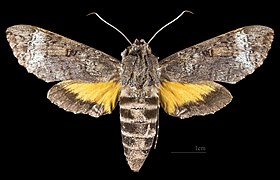| Isognathus australis | |
|---|---|

| |
| ♂ | |

| |
| ♂ △ | |
| Scientific classification | |
| Domain: | Eukaryota |
| Kingdom: | Animalia |
| Phylum: | Arthropoda |
| Class: | Insecta |
| Order: | Lepidoptera |
| Family: | Sphingidae |
| Genus: | Isognathus |
| Species: | I. australis |
| Binomial name | |
| Isognathus australis Clark, 1917 | |
Isognathus australis is a moth of the family Sphingidae.
Distribution
It is known from north-eastern Brazil.
Description
The wingspan is 70 mm for males. It is similar to Isognathus rimosa rimosa and Isognathus rimosa papayae but has narrower wings. The forewing upperside is unicolorous brown, shaded with white, except for a yellow band along the posterior margin and the faint traces of a distal marginal band. The basal area of the hindwing underside is yellow, the rest is brown with a bluish tinge, becoming black towards the anal angle.
Biology
There are probably multiple generations per year. Adults have been recorded in January.
The larvae have been recorded feeding on Plumeria species.
References
- "CATE Creating a Taxonomic eScience - Sphingidae". Cate-sphingidae.org. Archived from the original on 2012-11-11. Retrieved 2011-10-19.
 This article incorporates text from this source, which is in the public domain.
This article incorporates text from this source, which is in the public domain.
- "Silkmoths". Silkmoths.bizland.com. Archived from the original on 2012-10-10. Retrieved 2011-10-19.
| Taxon identifiers | |
|---|---|
| Isognathus australis | |
This Dilophonotini-related article is a stub. You can help Misplaced Pages by expanding it. |

